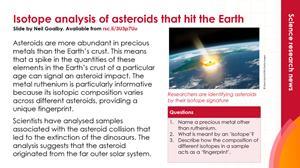Scientists track down asteroid likely responsible for dinosaur mass extinction
-

Download this
Use this story and the accompanying summary slide for a real-world context when studying isotopes with your 14–16 learners.
Download the story as MS Word or PDF and the summary slide as MS PowerPoint or PDF.
Isotope analysis has revealed that a rare type of asteroid called a carbonaceous chondrite was responsible for the impact that almost certainly brought about the extinction of the dinosaurs.

Earth’s crust lacks significant quantities of precious metals like platinum, palladium and ruthenium. These metals are much more abundant in asteroids and meteorites. Scientists can determine the timing of meteorite impacts by looking for spikes in precious metal quantities in the different layers of the Earth’s crust. Ruthenium can also provide clues as to where the meteorite originated from; ruthenium has seven stable isotopes and different extraterrestrial bodies have different ratios of these isotopes.
Long-distance traveller
The Chicxulub impact, assumed responsible for the mass extinction 66 million years ago, occurred just off the coast of Mexico and scattered dust all over the world. Researchers led by Mario Fischer-Gödde at the University of Cologne in Germany analysed ruthenium isotope ratios in samples of the Earth’s crust that originate from this time period. These samples were collected across Denmark, Italy and Spain.
The scientists found that the ruthenium isotope ratios for the crust samples all matched the ratio signatures for carbonaceous chondrites. These are a rare type of carbon-rich rock that are of particular interest because many cosmochemists think they show what the early solar system was made of. While the vast majority of meteorites that hit Earth originate in the current asteroid belt located between the orbits of Mars and Jupiter, the carbonaceous chondrites formed in much more distant reaches of the solar system.
This article is adapted from Tim Wogan’s in Chemistry World.
Explore these job profiles for careers context on A Future in Chemistry: atmospheric chemist and astrochemist.
Nina Notman
Reference
M Fischer-Gödde et al, Science, 2024, DOI: 10.1126/science.adk4868
Summary slide with questions and the article for context when teaching 14–16 lessons on isotopes: rsc.li/3U5xleS
Downloads
Origins of asteroid summary slide
Presentation | PowerPoint, Size 3.82 mbOrigins of asteroid summary slide
Handout | PDF, Size 0.35 mbOrigins of asteroid student sheet
Handout | PDF, Size 0.27 mbOrigins of asteroid student sheet
Handout | Word, Size 1.13 mb














No comments yet